Alfa Romeo 8C 2010 Owner handbook (in English)
Manufacturer: ALFA ROMEO, Model Year: 2010, Model line: 8C, Model: Alfa Romeo 8C 2010Pages: 223, PDF Size: 14.35 MB
Page 131 of 223
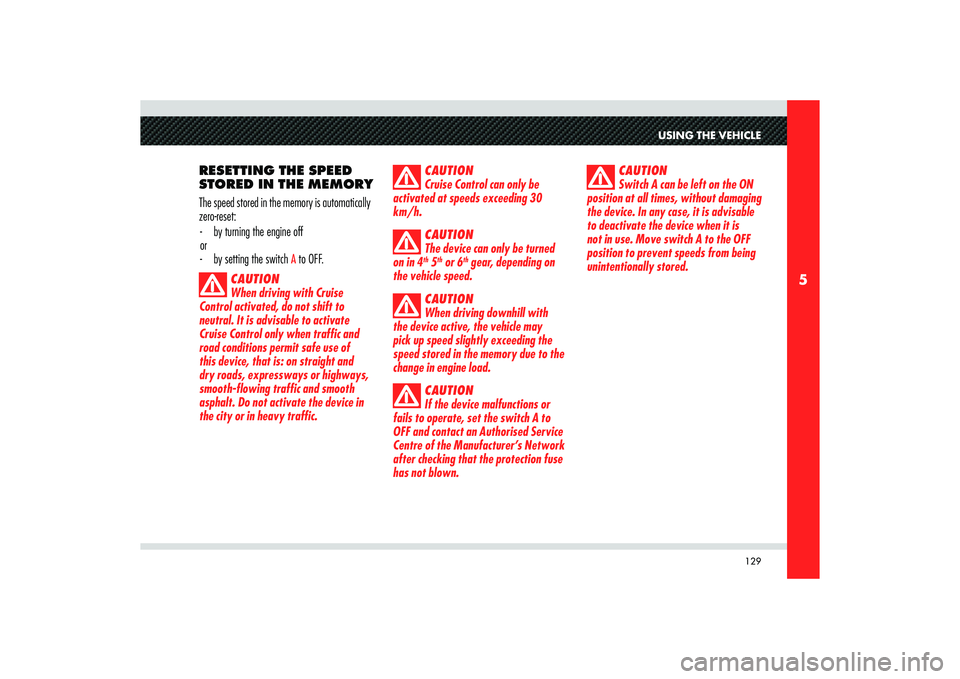
129
5
USING THE VEHICLE
RESETTING THE SPEED
STORED IN THE MEMORY
The speed stored in the memory is automatically
zero-reset:
- by turning the engine off
or
- by setting the switch
A to OFF.
CAUTION
When driving with Cruise
Control activated, do not shift to
neutral. It is advisable to activate
Cruise Control only when traffic and
road conditions permit safe use of
this device, that is: on straight and
dry roads, expressways or highways,
smooth-flowing traffic and smooth
asphalt. Do not activate the device in
the city or in heavy traffic.CAUTION
Cruise Control can only be
activated at speeds exceeding 30
km/h.
CAUTION
The device can only be turned
on in 4
th 5th or 6
th gear, depending on
the vehicle speed.
CAUTION
When driving downhill with
the device active, the vehicle may
pick up speed slightly exceeding the
speed stored in the memory due to the
change in engine load.
CAUTION
If the device malfunctions or
fails to operate, set the switch A to
OFF and contact an Authorised Service
Centre of the Manufacturer’s Network
after checking that the protection fuse
has not blown.CAUTION
Switch A can be left on the ON
position at all times, without damaging
the device. In any case, it is advisable
to deactivate the device when it is
not in use. Move switch A to the OFF
position to prevent speeds from being
unintentionally stored.
Page 132 of 223
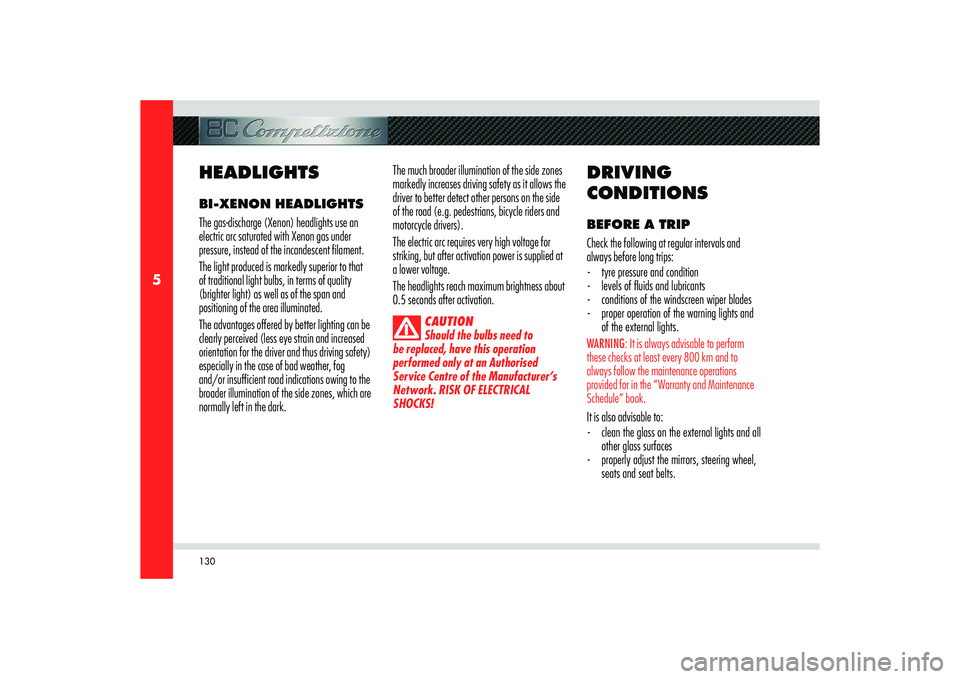
130
5
HEADLIGHTSBI-XENON HEADLIGHTS
The gas-discharge (Xenon) headlights use an
electric arc saturated with Xenon gas under
pressure, instead of the incandescent filament.
The light produced is markedly superior to that
of traditional light bulbs, in terms of quality
(brighter light) as well as of the span and
positioning of the area illuminated.
The advantages offered by better lighting can be
clearly perceived (less eye strain and increased
orientation for the driver and thus driving safety)
especially in the case of bad weather, fog
and/or insufficient road indications owing to the
broader illumination of the side zones, which are
normally left in the dark.The much broader illumination of the side zones
markedly increases driving safety as it allows the
driver to better detect other persons on the side
of the road (e.g. pedestrians, bicycle riders and
motorcycle drivers).
The electric arc requires very high voltage for
striking, but after activation power is supplied at
a lower voltage.
The headlights reach maximum brightness about
0.5 seconds after activation.
CAUTION
Should the bulbs need to
be replaced, have this operation
performed only at an Authorised
Service Centre of the Manufacturer’s
Network. RISK OF ELECTRICAL
SHOCKS!
DRIVING
CONDITIONSBEFORE A TRIP
Check the following at regular intervals and
always before long trips:
- tyre pressure and condition
- levels of fl uids and lubricants
- conditions of the windscreen wiper blades
- proper operation of the warning lights and
of the external lights.WARNING: It is always advisable to perform
these checks at least every 800 km and to
always follow the maintenance operations
provided for in the “Warranty and Maintenance
Schedule” book.It is also advisable to:
- clean the glass on the external lights and all
other glass surfaces
- properly adjust the mirrors, steering wheel,
seats and seat belts.
Page 133 of 223
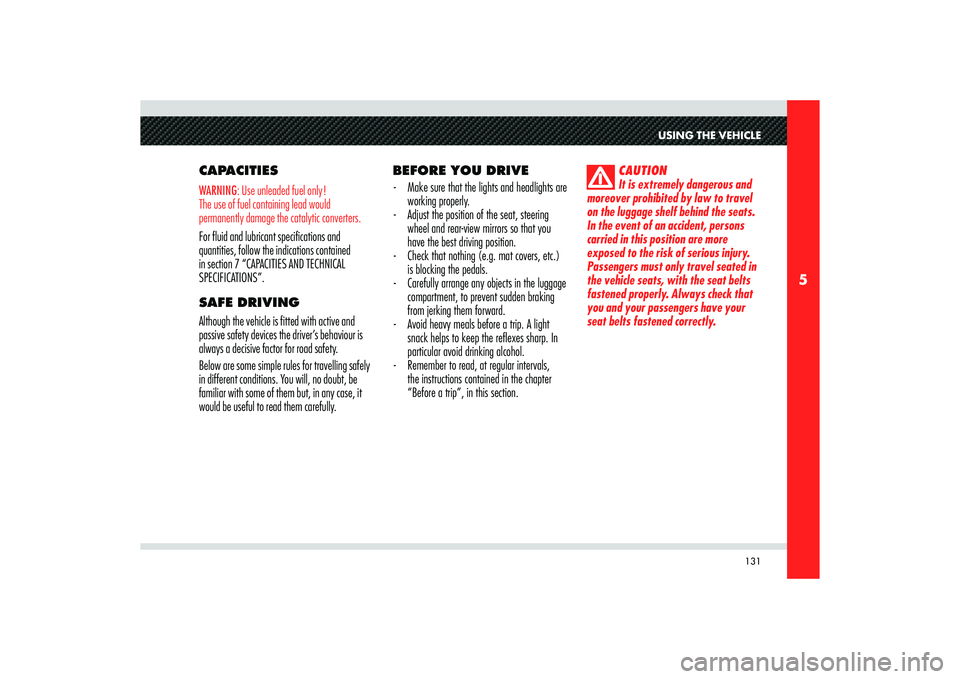
131
5
USING THE VEHICLE
CAPACITIESWARNING: Use unleaded fuel only!
The use of fuel containing lead would
permanently damage the catalytic converters.For fluid and lubricant specifications and
quantities, follow the indications contained
in section 7 “CAPACITIES AND TECHNICAL
SPECIFICATIONS”.
SAFE DRIVING
Although the vehicle is fitted with active and
passive safety devices the driver’s behaviour is
always a decisive factor for road safety.
Below are some simple rules for travelling safely
in different conditions. You will, no doubt, be
familiar with some of them but, in any case, it
would be useful to read them carefully.BEFORE YOU DRIVE
- Make sure that the lights and headlights are
working properly.
- Adjust the position of the seat, steering
wheel and rear-view mirrors so that you
have the best driving position.
- Check that nothing (e.g. mat covers, etc.)
is blocking the pedals.
- Carefully arrange any objects in the luggage
compartment, to prevent sudden braking
from jerking them forward.
- Avoid heavy meals before a trip. A light
snack helps to keep the refl exes sharp. In
particular avoid drinking alcohol.
- Remember to read, at regular intervals,
the instructions contained in the chapter
“Before a trip”, in this section.
CAUTION
It is extremely dangerous and
moreover prohibited by law to travel
on the luggage shelf behind the seats.
In the event of an accident, persons
carried in this position are more
exposed to the risk of serious injury.
Passengers must only travel seated in
the vehicle seats, with the seat belts
fastened properly. Always check that
you and your passengers have your
seat belts fastened correctly.
Page 134 of 223

132
5
TRAVELLING
- Caution is the fi rst rule for safe driving.
Being careful also means being in a position
to be able to predict the driving behaviour
of other drivers, that may be wrong or
careless.
- Keep a safe distance from vehicles in front
of you, adjusting this distance in accordance
to the vehicle speed and traffi c conditions.
- Strictly follow the traffi c regulations
applicable in each country and above all,
respect the speed limits.
- Long trips should be started in optimal
physical condition.
CAUTION
Drunk driving, or driving
under the influence of drugs or certain
medicines is extremely dangerous for
the driver and for others.CAUTION
Always fasten the seat belts.
Travelling without your seat belt
fastened increases the risk of serious
injury in the event of a collision.
- Make regular stops to loosen up your limbs
and refresh yourself, and avoid driving for
hours on end.
- Ensure that the air inside the passenger
compartment is changed constantly.
- Never coast downhill with the engine off:
the braking action requires greater effort on
the pedal due to the absence of the engine
brake and the power braking system. DRIVING AT NIGHT
The main guidelines to follow when driving at
night are set out below:
- Drive with the greatest caution: at night the
driving conditions are more demanding.
- Reduce your speed, especially on roads with
no street lights.
- At the fi rst signs of drowsiness, stop: to
continue driving would be a risk for yourself
and for others. Continue only after you have
had a rest.
- Keep the vehicle at a greater distance from
vehicles in front of you than you would
during the day: it is diffi cult to assess the
speed of other vehicles when you can only
see the lights.
- Make sure that the headlights are aimed
correctly: if they are too low, they reduce
visibility and strain the eyes. If they are too
high, they may bother the drivers of other
cars.
Page 135 of 223
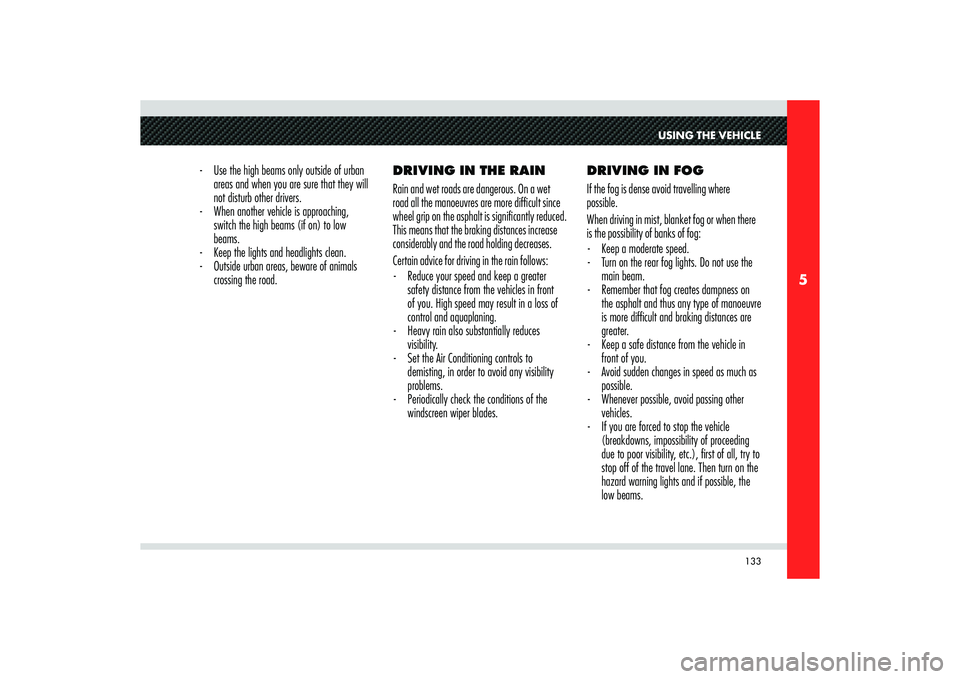
133
5
USING THE VEHICLE
- Use the high beams only outside of urban
areas and when you are sure that they will
not disturb other drivers.
- When another vehicle is approaching,
switch the high beams (if on) to low
beams.
- Keep the lights and headlights clean.
- Outside urban areas, beware of animals
crossing the road. DRIVING IN THE RAIN
Rain and wet roads are dangerous. On a wet
road all the manoeuvres are more difficult since
wheel grip on the asphalt is significantly reduced.
This means that the braking distances increase
considerably and the road holding decreases.
Certain advice for driving in the rain follows:
- Reduce your speed and keep a greater
safety distance from the vehicles in front
of you. High speed may result in a loss of
control and aquaplaning.
- Heavy rain also substantially reduces
visibility.
- Set the Air Conditioning controls to
demisting, in order to avoid any visibility
problems.
- Periodically check the conditions of the
windscreen wiper blades. DRIVING IN FOG
If the fog is dense avoid travelling where
possible.
When driving in mist, blanket fog or when there
is the possibility of banks of fog:
- Keep a moderate speed.
- Turn on the rear fog lights. Do not use the
main beam.
- Remember that fog creates dampness on
the asphalt and thus any type of manoeuvre
is more diffi cult and braking distances are
greater.
- Keep a safe distance from the vehicle in
front of you.
- Avoid sudden changes in speed as much as
possible.
- Whenever possible, avoid passing other
vehicles.
- If you are forced to stop the vehicle
(breakdowns, impossibility of proceeding
due to poor visibility, etc.), fi rst of all, try to
stop off of the travel lane. Then turn on the
hazard warning lights and if possible, the
low beams.
Page 136 of 223

134
5
Sound the vehicle horn rhythmically if you hear
another vehicle approaching.
- When you get out of the vehicle, put on the
high-visibility vest.DRIVING IN THE
MOUNTAINS
On downhill roads, use the engine brake,
engaging low gears so as not to overheat the
brakes.
- Never coast downhill with the engine off or
in neutral, and never with the ignition key
removed.
- Drive at a moderate speed and avoid
“cutting” corners.
- Remember that passing other vehicles when
driving uphill is slower and thus requires
more free distance on the road. If you are
being overtaken on a hill, slow down and
allow the other vehicle to pass. DRIVING ON SNOW OR
ICE
Below is some general advice for driving in these
conditions:
- Keep a very moderate speed.
- Fit snow chains or specifi c tyres if the road
is covered with snow: see the chapters
“Snow chains” and “Winter tyres” in this
section.
- Mainly use the engine brake and avoid
sharp braking.
- We recommend that you activate “Low
grip” mode (see page 122).
- Avoid sudden acceleration and sharp
changes in direction.
- During the winter season, even apparently
dry roads can have icy sections. Be careful
when crossing bridges, viaducts and roads
that have little exposure to the sun and are
bordered by trees and rocks. They may be
icy.
- Keep a safety distance from the vehicles in
front.
Page 137 of 223
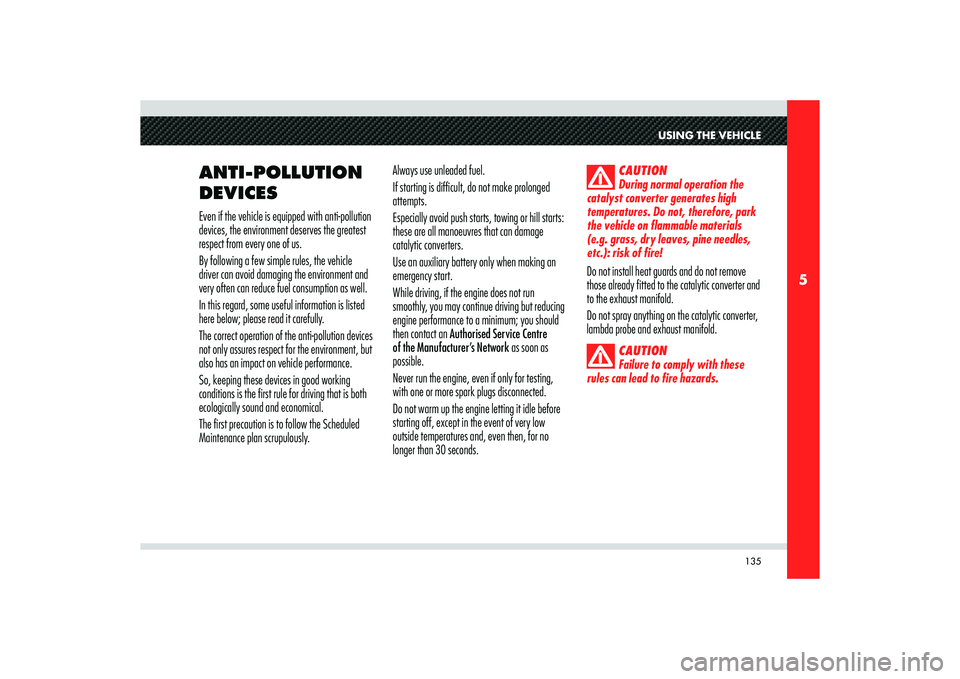
135
5
USING THE VEHICLE
ANTI-POLLUTION
DEVICES Even if the vehicle is equipped with anti-pollution
devices, the environment deserves the greatest
respect from every one of us.
By following a few simple rules, the vehicle
driver can avoid damaging the environment and
very often can reduce fuel consumption as well.
In this regard, some useful information is listed
here below; please read it carefully.
The correct operation of the anti-pollution devices
not only assures respect for the environment, but
also has an impact on vehicle performance.
So, keeping these devices in good working
conditions is the first rule for driving that is both
ecologically sound and economical.
The first precaution is to follow the Scheduled
Maintenance plan scrupulously. Always use unleaded fuel.
If starting is difficult, do not make prolonged
attempts.
Especially avoid push starts, towing or hill starts:
these are all manoeuvres that can damage
catalytic converters.
Use an auxiliary battery only when making an
emergency start.
While driving, if the engine does not run
smoothly, you may continue driving but reducing
engine performance to a minimum; you should
then contact an Authorised Service Centre
of the Manufacturer’s Network as soon as
possible.
Never run the engine, even if only for testing,
with one or more spark plugs disconnected.
Do not warm up the engine letting it idle before
starting off, except in the event of very low
outside temperatures and, even then, for no
longer than 30 seconds.
CAUTION
During normal operation the
catalyst converter generates high
temperatures. Do not, therefore, park
the vehicle on flammable materials
(e.g. grass, dry leaves, pine needles,
etc.): risk of fire!
Do not install heat guards and do not remove
those already fitted to the catalytic converter and
to the exhaust manifold.
Do not spray anything on the catalytic converter,
lambda probe and exhaust manifold.
CAUTION
Failure to comply with these
rules can lead to fire hazards.
Page 138 of 223
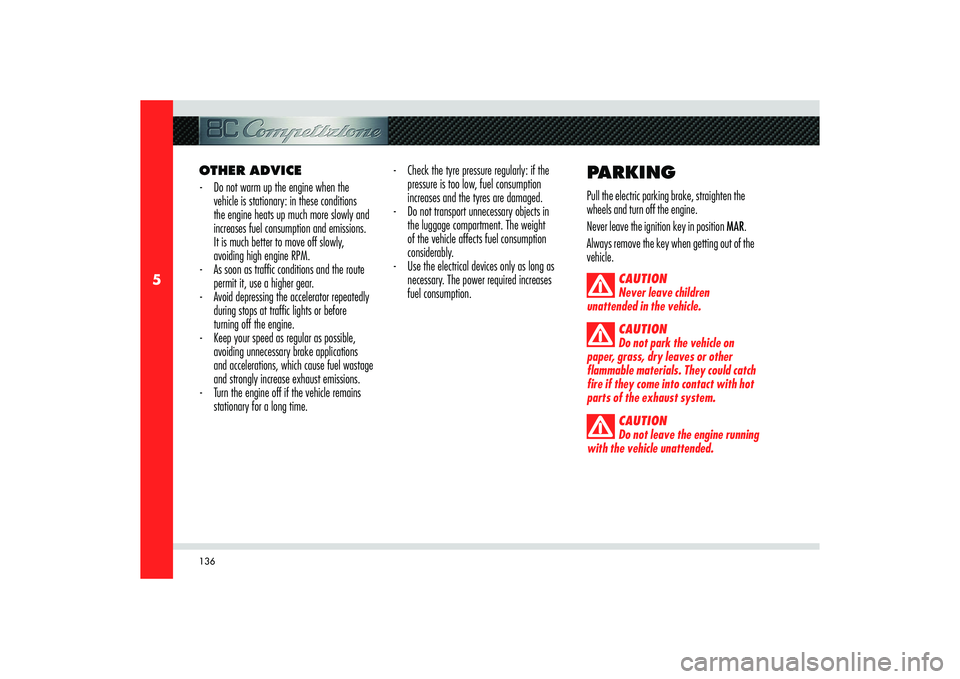
136
5
OTHER ADVICE
- Do not warm up the engine when the
vehicle is stationary: in these conditions
the engine heats up much more slowly and
increases fuel consumption and emissions.
It is much better to move off slowly,
avoiding high engine RPM.
- As soon as traffi c conditions and the route
permit it, use a higher gear.
- Avoid depressing the accelerator repeatedly
during stops at traffi c lights or before
turning off the engine.
- Keep your speed as regular as possible,
avoiding unnecessary brake applications
and accelerations, which cause fuel wastage
and strongly increase exhaust emissions.
- Turn the engine off if the vehicle remains
stationary for a long time. - Check the tyre pressure regularly: if the
pressure is too low, fuel consumption
increases and the tyres are damaged.
- Do not transport unnecessary objects in
the luggage compartment. The weight
of the vehicle affects fuel consumption
considerably.
- Use the electrical devices only as long as
necessary. The power required increases
fuel consumption.
PARKINGPull the electric parking brake, straighten the
wheels and turn off the engine.
Never leave the ignition key in position MAR.
Always remove the key when getting out of the
vehicle.
CAUTION
Never leave children
unattended in the vehicle.
CAUTION
Do not park the vehicle on
paper, grass, dry leaves or other
flammable materials. They could catch
fire if they come into contact with hot
parts of the exhaust system.
CAUTION
Do not leave the engine running
with the vehicle unattended.
Page 139 of 223
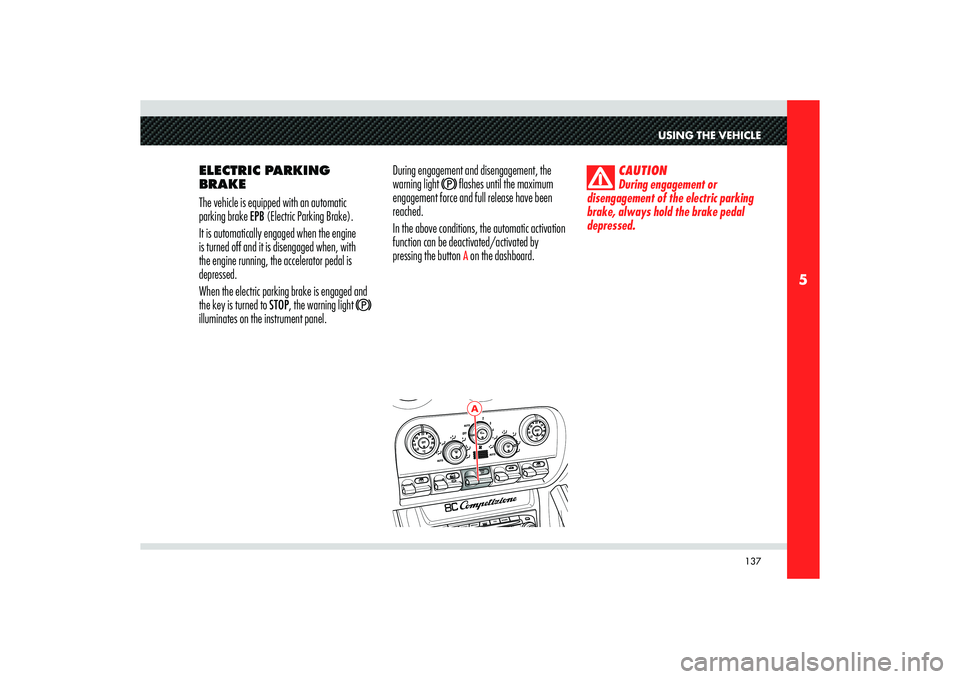
137
5
A
USING THE VEHICLE
ELECTRIC PARKING
BRAKE
The vehicle is equipped with an automatic
parking brake EPB (Electric Parking Brake).
It is automatically engaged when the engine
is turned off and it is disengaged when, with
the engine running, the accelerator pedal is
depressed.
When the electric parking brake is engaged and
the key is turned to STOP, the warning light
illuminates on the instrument panel.During engagement and disengagement, the
warning light
flashes until the maximum
engagement force and full release have been
reached.
In the above conditions, the automatic activation
function can be deactivated/activated by
pressing the button A on the dashboard.
CAUTION
During engagement or
disengagement of the electric parking
brake, always hold the brake pedal
depressed.
Page 140 of 223

138
5
B
Engagement
The electric parking brake is automatically
applied when the engine is turned off and the
vehicle is stationary.
It can only be disengaged when the engine is
restarted.
When the key is removed or set to STOP it
cannot be disengaged.
The electric parking brake can also be manually
engaged when the vehicle is moving or the key is
turned to MAR by pulling up the lever
B.
If the engine was turned off with the automatic
engagement device deactivated, you can
reactivated it simply by pulling lever B.
CAUTION
Always check that the vehicle is
actually locked before leaving it.
CAUTION
When the EPB button is
activated while driving, the vehicle
slows down with strong deceleration
(Dynamic Braking). It is therefore
advisable to use this function only
in case of an emergency. The vehicle
stability is in any case ensured by the
VDC system, which is always active.
Disengagement
The parking brake automatically disengages
when the accelerator pedal is depressed.
The electric parking brake can also be manually
disengaged when the vehicle is moving or the
key is in position MAR by manually pulling up
lever
B and simultaneously depressing the brake
pedal.
WARNING: In certain conditions it is however
advisable to manually disengage the electric
parking brake and brake the starting manoeuvre
slightly using the service brake. This is advisable
when there are obstacles very close to the
vehicle in the direction in which you intend to
move.